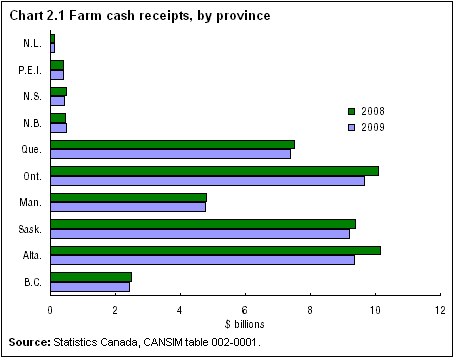Agriculture
Archived Content
Information identified as archived is provided for reference, research or recordkeeping purposes. It is not subject to the Government of Canada Web Standards and has not been altered or updated since it was archived. Please "contact us" to request a format other than those available.
Related information
Soft markets and difficult international factors took a toll on Canada's major livestock sectors in 2009. Lacklustre spring and summer weather hampered crop production as well. However, prices for the major grain and oilseed crops remained relatively strong.
Cold and drought early in western Canada's growing season and excessive moisture in eastern Canada stunted crops in 2009. In western Canada, a hot September and dry November enabled farmers to harvest later. They brought in a canola crop second only to the previous year's, and a wheat crop that was the second-best in nine years.
Market receipts for Canadian farmers were $40.9 billion from crops and livestock in 2009, 2.1% less than in 2008. Total net income amounted to $2.7 billion in 2009, down from $4.1 billion in 2008.
Receipts for crop producers totalled $23.0 billion in 2009, up 0.2% from 2008. Grain and oilseed prices have fallen from their peak in 2008 in part because of above–average world production in 2008 and resulting high levels of stock. The decline in prices was offset by an increase in the quantities sold in most of the major grains and oilseeds in 2009, as producers drew down their stocks from the bumper crop in 2008.
Including Canada Wheat Board payments, receipts from wheat (including durum, the wheat used for pasta) were down 13.0%, receipts from canola rose 2.5%, and receipts for potatoes increased 16.4% in 2009 compared with 2008.

View data source for chart 2.1
Livestock shipments fall
Livestock receipts declined $900 million to $17.9 billion in 2009. The 4.8% drop was largely the result of a sharp decline in the number of animals exported. Exports have been hampered by the stronger Canadian dollar, concerns about the H1N1 (swine) flu virus and country–of–origin labelling legislation in the United States. Another factor was lower demand for livestock products resulting from the global downturn. The number of live cattle shipped across the border fell 33.3% and the number of hogs shipped fell 31.7% from 2008 to 2009. Cattle prices were relatively stable in 2009, but hog prices fell 4.7%.
Receipts in the supply-managed sector—milk, poultry and eggs—rose 1.6%, mainly on higher dairy and poultry prices.
Across the livestock sector, higher grain prices pushed up feed costs for much of the year. Profits were also hurt by a strong Canadian dollar.
The number of cattle and hogs on farms declined in 2009. Hog inventories were down 2.8% to 11.8 million. The number of cattle—beef and dairy—dropped 1.3% to 13.0 million head as of January 1, 2010.
Most food is grown here
Canada is better positioned than most nations to withstand changes in the world food supply. In 2007, the majority of key food staples—even fruits and vegetables—were produced domestically: 81% of dairy products, 80% of meat, 76% of bread and cereals, and 60% of fruits and vegetables.
As well as importing nearly 40% of our fruits and vegetables, other popular import commodities are coffee, tea, sugar, rice, fish, and some fats, particularly olive oil—products that do not grow in Canada. Imports of fruits and vegetables totalled $8.1 billion in 2009. Imports of coffee, cocoa, tea and sugar totalled $6.6 billion.
- Date modified:

